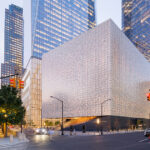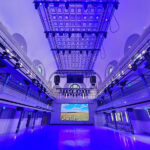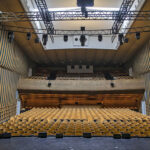It’s no shabby figure: a cool $446 million went into the design and construction of Miami’s new Carnival Center for the Performing Arts. And it shows. Boasting three theatrical spaces (the Sanford and Dolores Ziff Ballet Opera House, the Knight Concert Hall and the black box Studio Theater), the Center clocks in at an impressive 570,000 square feet. It’s the largest arts center constructed since D.C.’s Kennedy Center, and the Carnival Center sports more than cuttingedge architecture and a world-class architectural and design team. In fact, its lighting installations represent the best and brightest innovations — and a focus on flexibility that makes it stand out from the pack.
The Center took two decades to plan and implement, and the story of its construction is only slightly less dramatic than the grand operas slated for performance within its walls. But after bankruptcies, under-budgeting, bonds and a massive development effort, the space was funded — and architect Cesar Pelli and design associates Fisher Dachs Associates and Artec, Inc. could get to work creating theatrical spaces that pleased the eye — and offered plenty of candy for production crews as well.
Take the Ziff Ballet Opera House. With a 2,400-seat capacity and only slightly less stage space than New York’s Metropolitan Opera, the space called for some serious lighting. Richard Hoyes, associate at Fisher Dachs and head of the company’s lighting department since 1996, recalls the challenges of lighting the exemplary space. “We strove to integrate all of the technical equipment now expected for modern-day productions without compromising the aesthetic of the architect’s vision for this structure,” he notes.
That meant innovative and flexible lighting installations with some serious firepower. An assembly of 967 Strand Lighting CD80SV 800ms stage dimmers, (68 house dimmers and 88 non-dims for work lights) run lights, and non-dim circuits compose the Ziff Ballet Opera House’s dimming system. For greater flexibility, lighting fills the near side boxes of the space, with the option to remove the fixtures to allow for patron seating. The rear of the house features four followspots, while in-house lighting positions include lights along the circumference of the center ceiling dome, the front balconies on two levels and from pipes under side boxes.
In such a vast space, control is key. That’s why Fisher Dachs opted for a powerful Ethernet network, which ties together all major control components with a fiber-optic backbone system. Stage managers can use the portable wheeled rack, which allows controls to be positioned in a variety of locations onstage. The console’s AMX touch screen also controls work, house and run lights, and includes a separate cue light control panel.
Since the Ziff Ballet Opera House was designed for touring shows as well as in-house productions, Fisher Dachs designed a flexible system to accommodate outside technicians. Touring shows with their own equipment can avail themselves of eight 400A company switches to plug into for power, as well as Ethernet nodes for their control console and other DMX devices. During rehearsals, a company will typically bring the main console (a Strand Lighting 550i) out of the lighting control booth at the rear of the house and plug it into a floor box located beneath one of the seats. In addition, a laptop running Strand software is provided, creating an additional and highly portable control console for touring productions. Stage crews may work anywhere in the theatre without being tethered by wires, thanks to the wireless hand-held remove (WRFU).
Stage lighting instruments in the impressive lighting array feature 650 ETC Source Four ellipsoidal reflector spotlights and PARs, four Lycian 1293 X3K 3000-watt followspots, two Lycian Starklite II 1272 1200-watt followspots, four Martin MAC 2000 Profile luminaires and four MAC 2000 Wash luminaires.
As impressive as the Ziff Ballet Opera House is, it’s just one of the Carnival Center’s installations. The Knight Concert hall was designed to furnish an ideal setting for acoustic, classical, pop, jazz and other performed music, all while accommodating more than 2,000 seats and a light wood interior.
The aims were ambitious, but the necessary acoustic flexibility of the space presented some problems straight away. The theatre required five tools for acoustic quality: an adjustable canopy, a control chamber, a loudspeaker system, retractable fabric panels on the walls and the room itself. But the design scheme’s showpiece — a spiral-within-a-spiral acoustic canopy that weighs in at around 130,000 pounds — did more than blend acoustics with aesthetics — it also presented a serious lighting challenge.
“The canopy was unique, but also challenging,” concedes Hoyes, who notes that the canopy’s location made it impossible to install lighting components in customary theatrical positions on the ceiling of the Knight Concert Hall. Not only was the canopy to double as a primary lighting position, but it also could be raised or lowered to alter sound reflection, with a net effect of making the space larger or smaller. This flexible and adjustable ceiling height meant that fixed focus fixtures were out of the question, prompting Fisher Dachs to innovate with automated luminaires.
One-hundred-and-sixty Vari*Lite VL1000 Tungsten and 12 VL500 Tungsten luminaires were marshalled, providing versatility. The luminaires provide a warm white light system appropriate for the symphony orchestra while giving crews the opportunity to light pop events or rock concerts with colored and patterned lights. Forty-eight recess-mounted Edison Price Darklite 1000W PAR 64 fixtures serve as rehearsal lights for the space, providing an adequate amount of stage lighting for rehearsals without using the automated luminaries.
The lighting components in the Knight Concert Hall are tied together with an extensive Strand Lighting ShowNet Ethernet network, which provides a fiber-optic backbone system similar to that used in the Ziff space and which allows all of the lighting control components onstage to be accessed simply and swiftly. A Flying Pig Systems WholeHog 3 control console from High End Systems oversees all of the stage and rehearsal fixtures. The dimming system is equally highpowered, featuring 300 Strand Lighting CD80SV 800ms “high-rise time” stage dimmers, 148 house dimmers and 70 non-dims for work lights, run lights and non-dim circuits. Fifty-six ETC Source Four ellipsoidal reflector spotlights, 24 Strand Lighting Bambino 650 Fresnels and 24 Lycian SuperStar 1.2K followspots complete the equation, creating a flexible lighting scheme that can alter based on the type of performance. Custom architectural lighting for both the Ziff Ballet Opera House and the Knight Concert Hall was provided separately by Brandston Partnership.
True to its behemoth budget, the Carnival Performing Arts Center and its lighting scheme have received kudos from clients, patrons and critics who have attended the various galas and initial performances both at the Ziff Ballet Opera House and the Knight Concert Hall. However, time will tell if the space’s price tag will pay off. Reports from the Miami Herald suggest that monthly ticket sales have fallen far short of projections. However complex the marketing of a mammoth new theatrical complex, the designers of the space can rest assured that they have created a lighting scheme that reflects the purpose of the center and its potential.


